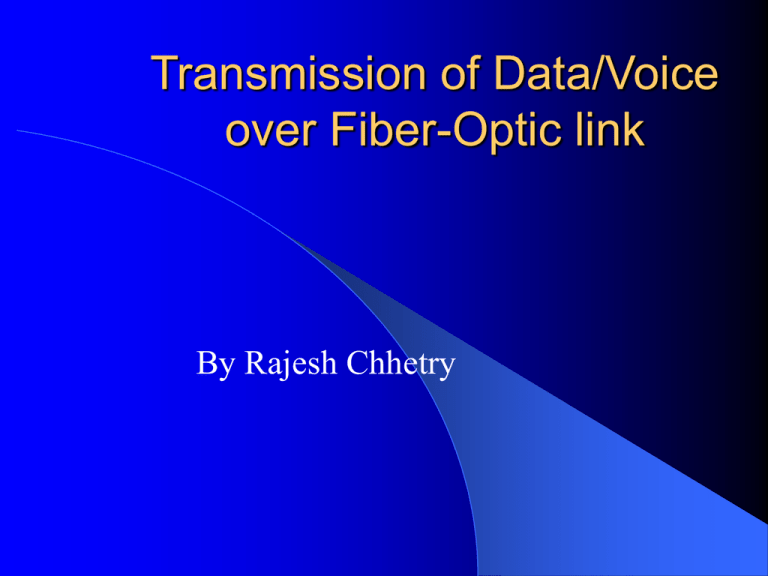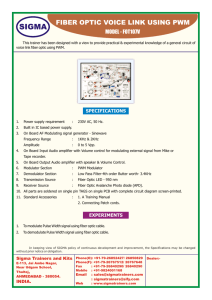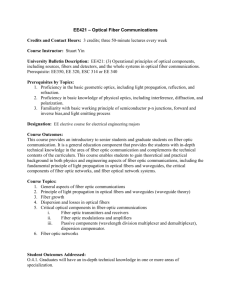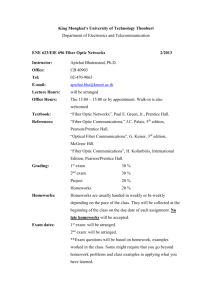Transmission of Data/Voice over Fiber-Optic link
advertisement

Transmission of Data/Voice over Fiber-Optic link By Rajesh Chhetry Objective The main objective of this paper is to make a comparative study among different principles ,technologies and practices that involve in the transmission of data over fiber optic link and recommend a communication system that perfectly meets the requirements of communication of data in the current trend and environment. Introduction In recent years it has become apparent that fiber-optics are steadily replacing copper wire as an appropriate means of communication signal transmission They span the long distances between local phone systems as well as providing the backbone for many network systems This paper is about the different principles involved in a fiber optic communication. Fiber Optic technology fiber-optics use light pulses to transmit information down fiber lines The transmitter accepts coded electronic pulse information coming from copper wire The information is then processed and translated into equivalently coded light pulses. A light-emitting diode (LED) or an injection-laser diode (ILD) can be used for generating the light pulses . Light pulses move easily down the fiberoptic line because of a principle known as total internal reflection Elements of Optical fiber cable The optic core An optic cladding, A buffer material, A strength material The outer jacket Fiber optic applications (Data) Backbone architechture for telecommunication links Cable service providers /High speed internet Trunk lines Monitor power grid systems Local area networks Fiber optics economics One of the initial economic factors to consider when converting to fiber-optics is the cost of replacing wire systems with fiber Increased demand for optical fiber has brought the prices down within competitive range of copper In the short term it is often less expensive to continue using copper cabling for covering expanded communication needs In the long term it may be more cost effective to invest in conversion to fiber-optics . This cost effectiveness is due to the relative ease of upgrading fiber optics to higher speeds and performance. It is generally accepted that customers will need increased bandwidth as the information highway grows Fiber optics will play a pivotal role in this race since the bandwidth needed for providing an all-in-one service with television, telephone, interactive multimedia, and internet access is not available in much of the wiring of America. Single Mode and multimode fibers Single mode allows only one mode of ray to pass through it’s core. Multi- mode allows hundreds of rays of light to propagate through the core. Encoding The source information (such as audio, video or sonar) comes in many forms . The first step is to convert the information into a bit-stream . once the information is stored electronically and whatever the form, data can be converted into raw binary data prior to transmission. Base Band Modulation The next step is to modulate the baseband and this is where, in constructing an optical communications system, we start making compromise . Different modulation schemes make varying use of the bandwidth, but the trade-offs will include distance, compression, BER and power. Due to the lack of 'coherent' optical systems for extracting phase information, optical communication systems use pulse code modulation (PCM) schemes to modulate the baseband . There are many PCM techniques available.HDB3 is the most advanced and efficient technique developed so far. HDB3 Light Sources Leds- produce incoherent light that severely reduces the obtainable bandwidth . Laser Diodes-Lasers produce coherent light and deliver far higher performance than LEDs e.g Fabry–perot laser Recommendations With reference to the study about the fiber optics systems , the following communication system can be recommended for an efficient and reliable data transmission. Fabry- perot laser diode Pulse code modulation technique used for producing bit streams Encoded using HDB3 codes Single Mode step index fiber This can be a solution for the requirement of the data-on–demand system implemented by businesses today. The requirement for such a system is high Bandwidth. Summary Based on industry activity, it is evident that fiber-optics have become the industry standard for transmission of information. The choice is not whether to convert to optical fiber, but rather when to convert to optical fiber. It is most likely that we will be able to use it in our local networks in the days to come. encoding techniques PCM: pulse code modulation samples of the analog data taken each sample quantized samples transmited as digital signal received samples used to reconstruct analog data example: samples voice channels taken 8000/sec quantized to 7 bits synch. bit added -> 8 bits 8 x 8000 = 64000 bps, standard digital voice channel






